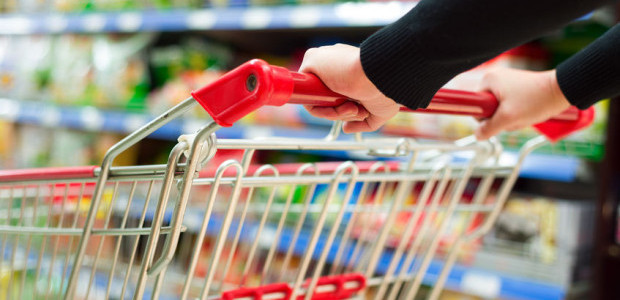
Getting to zero waste is about mindfulness — #ThinkingTwice before we buy. (Image: Gui Yongnian/123rf)
I recently learned about the magic that occurs when consumers are asked to pay a small fee for a
shopping bag. Being forced to pay a nickel at checkout counters in Washington DC resulted in a whopping 60% decrease in bag use. (Source: Washington Post). This got me thinking about the power of #ThinkingTwice before buying the things that we put into those shopping bags.
Getting to zero waste in our homes, offices and communities is not just about recycling, deciding what goes into the blue bin and what goes into the green bin. It’s not about not buying anything (which of course, is hard to do in our modern society). It’s not about minimalism (admirable but out of reach for most). And it’s not about shifting purchases to ‘experiences’. (One airplane trip can wipe out all the environmental ‘gains’.) Getting to zero waste is about mindfulness — it’s about getting into the habit to #ThinkTwice before we buy.
#ThinkTwice By Asking Questions
Getting to zero waste is about all the questions we can ask when deciding what to buy, whether to buy at all, how to get the most out of the products we do buy, and how to ensure that all the things we buy are responsibly disposed of. Many of these questions refer to the eco-impacts that occur over the full lifecycle of the product, starting with how materials are sourced and ending with where an items ends up.
#ThinkTwice About Buying Something You Don’t Need
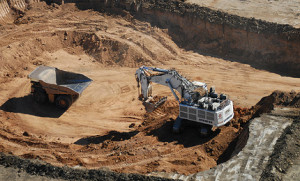
For every ton of municipal solid waste exists a corresponding 71 tons of mining, manufacturing and agricultural waste (Image: Mining-Technology.com)
Do I Need to Buy This? Generating waste starts with the decisions one makes about whether to buy at all. Every product uses resources and creates waste during its manufacture. According to the Institute for Local Self Reliance, behind every ton of municipal solid waste lies 71 tons of industrial waste generated from sources such as manufacturing, mining, and agriculture.
So, buying mindfully is about using your personal ‘resource budget’ to buy what’s most important, and filter out the impulse purchases that may feel good at the time but could wind up making you feel guilty later on.
Buying mindfully is about trying to better understand why you’re buying something, and if you’re buying for albeit important human needs like status or identification rather than necessity, deciding whether those needs are worth the environmental and resource investment, or can be satisfied in some other way.
#ThinkTwice About Buying New
As someone more pithy than I reminds us, ‘The greenest product is the one that already exists.’ So, once you’ve decided you really need something, cut down on the ‘invisible waste’ associated with sourcing and manufacturing that item by deciding whether you can buy it used instead of new, or if you can simply gain access to the same type of item through a means other than purchase
We don’t need to buy every thing we use new! There are alternatives that can even help us find potentially higher quality items than what’s commonly available today, like borrowing it from a friend, or asking someone in your gift community to give you one for free. Of course, you can also buy it used at a thrift or consignment shop, or online at Craigslist.org or eBay.com.
I am excited about a new website called NextDoor.com. It’s like a Linkedin for neighbors. I’ve already asked my own ‘Next Door’ neighbors if I could borrow a book I couldn’t get at my New York Public Library branch, while others have asked to borrow my bike. An alternative, some buildings and neighborhoods have created their own listserves.
#ThinkTwice about Buying the Flimsy and Disposable

Infrequently used hand tools are an excellent thing to share with others as opposed to owning. (Image: BobVila.com)
How Long Will This Last? When you shop, look for quality items that can last a long time. Look for durable items that can be used by multiple users over their lifetime, and can be repaired or repurposed when they are no longer useful to you.
In a move to combat product obsolescence, the French government recently passed a law requiring local manufacturers to offer a two year warranty on most products, and to disclose the number of years they will make spare parts available.
Get familiar with the term ‘intensity of use’, a strategy for getting the most use of all the energy and materials that went into making, transporting and using products. Ask if the products you buy are designed to withstand the ‘wear and tear’ of not only your own use, but potentially multiple others who might share it. Power drills are typically designed to be used by one person for an average of 6 hours over their lifetimes. But with the advent of tool lending libraries, manufacturers will need to make those drills not only last longer, but stand up to the test of multiple DIYers.
#ThinkTwice About Buying Virgin
How Was This Made? Consider the kinds of materials that are used. Waste-aware consumers ask: Is this product made from recycled materials? And its corollary: Is this product recyclable in my community?
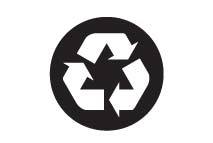
Depending upon the accompanying text, the Chasing Arrows logo on an item can denote its ability to be recycled and/or that it is made of a specified amount of recycled material.
Using recycled materials often saves energy and resources over new. Recycling items nearby creates less greenhouse gas emissions than transporting them to MRFs far away. The lighter the products and packages (think ‘plastic’), the greater the environmental burden.
As I pointed out in this article, in order to close the recycling loop, consumers need to help create demand by buying products made from recycled materials. And, making products from materials that can be recycled in one’s own community makes sorting for recycling easier and less environmentally impactful. I’d love to see a ‘Locally Recyclable’ label on products and packages, letting me know the items I buy can be recycled safely and efficiently right nearby — how about you?
#ThinkTwice About Buying Guzzlers
What About Everything Else in Between? Often, the greatest impacts associated with owning and/ or using products is what happens between purchase and disposal. It’s about all the ‘consummables’ like energy, water, paper and toner used by light bulbs, showerheads, and printers. Other considerations might include the space a product takes up in closet, or even in some instances, the risk it might pose by lying around.

Vacuum cleaners are used, on average, 20 minutes every other week, suggesting the opportunity to share one machine among neighbors in a multi-family apartment building.
My new neighbor has opted not to buy a vacuum cleaner, but rather, borrows mine on that every other week occasion when she tidies up. Her resourcefulness to borrow — and my willingness to lend — cut down on at least one redundant vacuum cleaner in my 128-unit NYC apartment building.
Here’s a big idea: In addition to price tags, maybe we can petition businesses to put ‘cost of ownership’ tags on products, so we can more precisely calculate right while we’re shopping what it will really cost us to own a product right up until the time (and including) we’re ready to move it on. Cutting down on costs typically correlates with waste and environmental impacts.
#ThinkTwice About Buying Items That Are Not Reusable
Ask: Will this be something that someone else might want to use? And will it be easy to find others whom I might I pass it along to later on? Some day we will likely rent many products from manufacturers or service providers who will address these matters for us, but for now they remain genuine needs for waste-aware consumers.
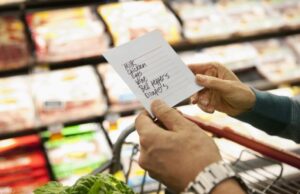
Using a shopping list can help you cut down on unnecessary purchases. (Image: NY Daily News)
#ThinkTwice Every Time You Shop
So starting today, and every day that you shop, bring along a reusable bag or two – CHECK, a shopping list – CHECK, and a mental list of questions that will help you think more holistically about all of the impacts and all of the different kinds of waste associated with the products we buy – CHECK.
Explore new ways of accessing goods – like sharing, borrowing and lending, that can help you not only cut down on waste, but save some money and build community, too.
Think long term and holistically about all the ramifications of what might be a quick purchase. Consider petitioning businesses and governments to help fill in the data gaps that can help you make more intelligent purchasing decisions right in the store.
(P.S. If it’s not totally noticeable by now, I’d love to start a new hashtag — #ThinkTwice. What do you think? Worth a shot? – Jacquie Ottman, Founder, WeHateToWaste.com)
Posting Guidelines
This and other stories published on WeHateToWaste.com are intended to prompt productive conversation about practical solutions for preventing waste. Opinions expressed are solely those of the contributors and WeHateToWaste implies no endorsement of the products or companies mentioned. All comments will be moderated. All postings become the property of WeHateToWaste.com.

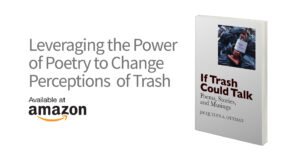

Before reading this article I had never heard the 1:71 ratio between MSW and industrial waste. It’s an alarming fact considering industrial waste is generally more toxic and more difficult to dispose of, often polluting large areas by leaking into groundwater etc. It reminded me of yet another example of an article entitled, The Tragedy of The Commons by Garrett Hardin. The article states that the 100% of the benefits of what we buy go directly to the user and only the user , but the disadvantages are evenly distributed amongst the commons, suggesting that the biggest hurtle in addressing overconsumption is lack of community. Thus, the shift to a sharing economy with sites like Air B&B and Nextdoor are more crucial than we even realize.
Jacquie – LOVE this post. This is exactly how I feel and what I try to tell family/friends when they buy something new!
Recently there was talk in my state in Australia about banning plastic bags and you should have seen the uproar – people were not happy. Think starting by charging a small fee for a carry bag would be a good first step.
Hope the hashtag takes off!
Beth
So good to hear from you! Glad you like the post. We are trying to get this #ThinkTwice hashtag going. Mindfulness is at the heart of reducing wastefulness, as you well know. Speaking of bags, read all about it in your papers this a.m.: NYC just passed a plastic bag law yesterday. Feels great to have been an active part of it! Hope you are doing well, Beth. We miss you!
Jacquie
Have been reading and sharing some of your wisdom (should be COMMON SENSE!!!) through my job as I’m trying to reduce waste there. But this ONE post struck such a strong chord that I’ve linked it to my personal site – I’ve got LAND to share, but need folks who strive toward net zero, or what’s the point? your post is a very clear way to let them know the expectations. sometimes it feels hopeless, but can’t stop trying. thanks!
Jacquie,
Great advice! It can be very tempting to make impulse purchases, but if you know what your triggers are you can reduce your susceptibility. For example, I don’t shop hungry because if I do I know I will buy more food than I need. Making a list and sticking to it is one of the best ways to make sure you think before you buy.
Thanks for the tips!
Dave, you hit on a biggie — impulse purchases. I think writing a list and sticking to it is a good one. I wonder if there are others. I bought some clothes on impulse today. I wonder if I had to leave them in the store, return in a week, how I would still feel? Just one thought here… what do you think?
JO
I think that’s a great strategy. Even just waiting a day or two is probably long enough to give you a better perspective and some time to decide whether or not you really need that particular item.
Jacquie, thank you for the advice. This is a great post that all buyers should definitely read!
I agree with David. Impulse purchases are very common buying habits. We must plan ahead in order to reduce this. For me, I usually make a list of items to buy before I go shopping. I leave my house with enough money only to buy the items listed on the list. I usually find unexpected things that I really want to purchase once I get to the store, but I end up not buying them due to the budget issue.
Reading your post, I plan to shorten my list by #ThinkingTwice about the listed items before leaving home!
Setting a budget for yourself is another great tip! I hadn’t thought of that. A budget will make you think about what’s truly necessary and what’s superfluous.
I think that #thinkingtwice while shopping puts more responsibility in the hands of the consumer. Consumers should not just mindlessly buy things without considering the impacts. Inside the store is where all of the important decisions are made and so it is necessary to teach smart and sustainable shopping. In an effort to eat healthier, I have found it much easier to resist eating junk food when I make the decision in the store. If I choose not to buy it, it will not be sitting in my kitchen cabinets taunting me. To help consumers shop smartly, it would be interesting to have labels on everything, estimating what resources were needed to produce it. I wonder if this would help people #thinktwice about buying items if this label gave them a visual idea of the waste involved. Would everyone in the process of producing an object think more about how sustainably the objects were produced if they had to disclose this information?
I believe New York City tried to pass a bag tax. It’s a shame that it didn’t go through, but in due time, more and more cities will likely pick up this fee. A great way to reduce waste and change customer behavior!
Lately, #thinktwice is exactly what I do while deciding on an item to purchase. Before impulsive shopping was a no-brainer, but after a bit of research on how a simple shirt is produced, and realizing the amount of labor and natural resources a simple shirt needs, I quickly reconsidered my habits. Your post eloquently dissects the truth behind our current industries, such as apparel. Thankfully, thrifting has always been a second nature of mine, but not for many. However, I do enjoy your alternative, lending and borrowing with your neighbors. This is a perfect opportunity to get to know them, while building a sense of community.
Repetition is prime in eliminating any bad habits. I noticed that after I stopped and thought about the products I purchased on a daily basis the actual urge to buy the product diminished, and now I can gladly say I do not suffer from post consumer behavior.
I really appreciate posts like this because even as someone who makes an effort to reduce my personal waste and to not buy in excess, I think there is always something more to learn and I think it’s helpful to hear anecdotes and suggestions of what works for different people and how. Posts like this are also important to make less “environmentally-oriented” people more mindful about their impact on the environment. A little food for thought from this article was that I had never before thought about sharing a vacuum cleaner with a neighbor. However, in college each floor of every dorm had a communal vacuum cleaner that residents shared and could use at their disposal. If it worked there, why shouldn’t it work in a NYC apartment building? Thank you!
I remember moving from New York to DC for school and being completely shocked that there was a 5 cents charge for each plastic bag. At first it didn’t sound like it would make a dent in my pocket, but after living there for a long period of time, you realize that how much you should be using reusable bags. It came to the point that if my roommates and I forgot our reusable bags, we would end up carrying our groceries down the block without a bag than opting to buy a plastic bag. After moving back to NYC, I stopped asking for a bag at the supermarket or bringing my own. Some cashiers have given me funny looks, but once you start bringing reusable bags everywhere, it becomes inherent, honestly!
Great list of things to think about. You’re so right when you say that it’s not just about the physical things that we buy and use–it’s also about the waste that’s generated to produce them and what it takes to dispose of them. Those things can be quite difficult to discern when you’re standing in a store aisle, so I know I’ll find these guidelines really helpful.
Labels have such a big impact on purchase decision-making, whether we realize it or not. A simple GMO label makes something more attractive to many shoppers, who don’t even really know what a GMO is! Countries who trade with the US threatened to impose great fees if a bill was passed that would put a label on meat stating the meat’s country of origin, because they knew the power of labels.
Using labeling as a method of helping people #thinktwice is a great idea. Whether it’s “Locally Recyclable” or adding the cost of ownership. It would be hard to get the latter past the big pockets and hands of lobbyist, but the former would be a great way to, not only let people know whether something is locally recyclable, but educating people that long-distance recycling is an issue at all!
Jacquie – what a great post! It is succinct, thorough, and the actions suggested can be easily carried out by everyone. I partake in some of these already but I definitely want to incorporate more of #ThinkTwice into my shopping mindset. I wish I could post this inside every store!
I work in retail currently and the biggest realization I have had is how suppliers create so much waste. We will get shipments of dozens of cardboard boxes full of bubble wrap where inside are individually boxed items with even more bubble wrap! We recycle as much as we can and give the bubble wrap to local artists who use it to sell and ship their work, but it would be great if there was a way to cut the waste from the source. I know suppliers want to protect the items being shipped if fragile, but I wonder if there could be a way for them to use reusable boxes and fill them with a reusable material (maybe fabric?) that would all be picked up later for reuse. Any thoughts?
In a previous comment you mentioned impulse purchases and how if you left it in the store for a week, would you still want it? I can attest to the fact that you may not want it! In the store that I work in employees can put clothes in a ‘hold pile’ to buy later. There have been many instances where I try something on and LOVE it, but a week later when it is still sitting in my hold pile I realize I really don’t need it. It’s great because I can enjoy my time shopping, but save myself the money of impulse buys!
Great insights there on ‘retail inertia’, Lindsey. I suspect there’s a very high rate of products that never get returned due to inertia. And this is especially so after Christmas, hence my idea to hold a regift swap. See this link: http://www.wehatetowaste.com/regift-party/
About packaging, I suspect despite being plastic, the air pillows are among the most material efficient forms of dunnage there are.
Ms. Ottman, thank you for such a thoughtful post that makes #thinktwice feel so achievable! While impulse purchases and spending less money for a low product good can be tempting, I know that in the long run I will only feel guilty about buying such a resource-intensive and useless product. I hope we can get the word out about thinking twice! It scares me how disconnected I feel from the extraction of resource and production process that goes into goods that I use in every day life.
This is a great post! It actually makes such a big difference in shopping when I think to myself, “Do I really need this?” because it really makes you think twice about what you’re buying. You save money and use less at the same time.
A very wise list. I’m incredibly happy that this doesn’t tell consumers to cut out consumption but effectively gives tips on how to reduce waste and inefficiency (in a sense, how to be an ecosmart consumer). Often, only when it truly hurts our pockets do we begin to cut down on unnecessary purchases as shown with the plastic bag tax in D.C. But teaching others how to reduce (because recycling can only go so far) is a great way to start getting others to understand the real environmental cost our unnecessary purchases have and how its long term effects will most definitely affect not just our pockets but our quality if life as well.
When I started reading this post, I immediately thought about the Scandinavian culture and mindset. In most countries in the region customers have to purchase plastic bags in supermarkets and grocery stores, which greatly influences people to bring their own reusable bags or carts when they go shopping. Additionally, every supermarket has a machine where people can recycle their plastic and glass bottles and receive some money back for it. Despite the fact that American culture does not have this recycle, reduce and reuse mindset, changing the legislation can have an immense impact in influencing people to reduce their ecological footprint and become more environmentally conscious in their daily lives. Since plastic bags can’t be recycled, “coercing” customers to purchase them is such an effective way to reduce the amount of waste that isn’t biodegradable.
This post also reminded me of an essay called “The Next Industrial Revolution”, where the authors condemn the term “eco-efficiency”, advocating that it does not solve the problem of waste. The essay was written in the early 2000s and it emphasizes how products and their respective packages should be made of biological nutrients, and thus when thrown away can be decomposed. Today there are so many more options of stores and products that we can purchase to lead a more waste-free life. After reading this post, I am definitely going to think twice about what I can substitute in my convenient life for a biodegradable and compostable option and thus conquer one more step in living a life where I produce less waste.
Pingback: How to Treat Yourself and Stick to Your Budget - My Journey to Millions
Pingback: Think Twice Before You Buy: Shop Smart & Save!
Pingback: It's time to 'do your share by sharing' for the sake of environmental sustainability - Weshare